Ultimate Guide to Exercises for Lumbar Herniated Disc Relief 2
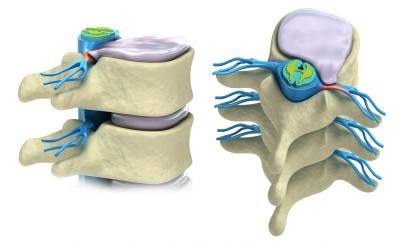
Did you find our previous article, “Disc Herniation Part 1,” helpful but are still battling discomfort? Are you eager to discover exercises that can effectively reposition your herniated disc and enhance your well-being? You’re in the right place.
In this comprehensive guide, we’ll cover:
- Effective Exercises for Repositioning a Herniated Disc: Learn the top movements to gently coax your disc back into alignment, reducing pain and improving mobility.
- Stabilization Techniques to Prevent Disc Displacement: Discover exercises that strengthen your core and back, ensuring your discs stay in place.
Understanding Lumbar Disc Herniation:
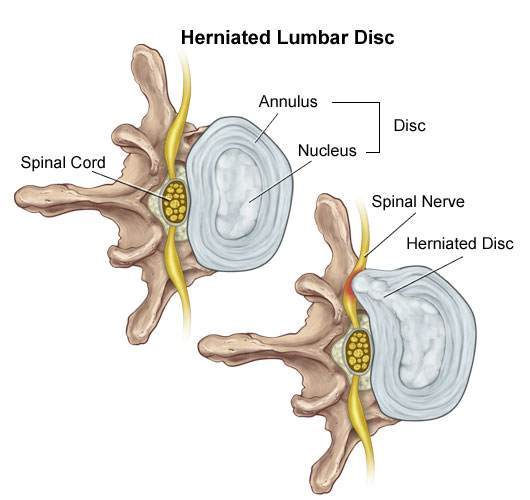
A herniated disc occurs when the disc’s nucleus breaks through the annulus, as shown in the illustration from neurosciences.beaumont.edu. But what triggers this displacement? The primary culprit is forward bending, which compresses the disc (think of it as a jelly-filled doughnut) and can lead to the annulus fracturing, allowing the nucleus to protrude and press against nerves.
Why Does it Hurt?
The disc’s exterior is tough cartilage, while its interior is softer, akin to mucus. Applying pressure on one side forces the inner material to the opposite side, similar to squeezing a doughnut. When a herniated disc or inflammation puts pressure on a nerve, pain ensues. The key to relief is applying counterpressure to reposition the disc.
For a deeper dive into herniated discs, refer to “Disc Herniation Part 1: Best Self-Treatments for Lumbar Disc Herniation.“
How to Apply Counterpressure:
The strategy involves bending your spine backwards or into the extension to shift the disc away from the nerve.
Exercises to Reposition a Herniated Disc: Note of Caution:
Initially, these exercises might intensify your pain slightly. If pain significantly worsens or radiates further down your leg during these exercises, cease immediately and consult a professional.
Exercises for Lumbar Herniated Disc
#1 Prone Lying Lumbar Herniated Disc
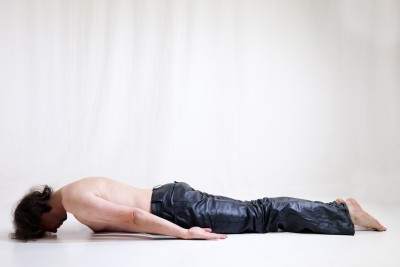
- Lie face down or prone in bed with your elbows tucked in under your side:
- As soon as you get up in the morning you should lie prone (face down). By getting in this position, your lower back becomes more arched, or as doctors say, you increase your lordosis.
- The increased lordosis pushes on the back of the disc helping to bring the nucleus forward into the correct position.
#2 Sphinx pose in Yoga For Lumbar Herniated Disc
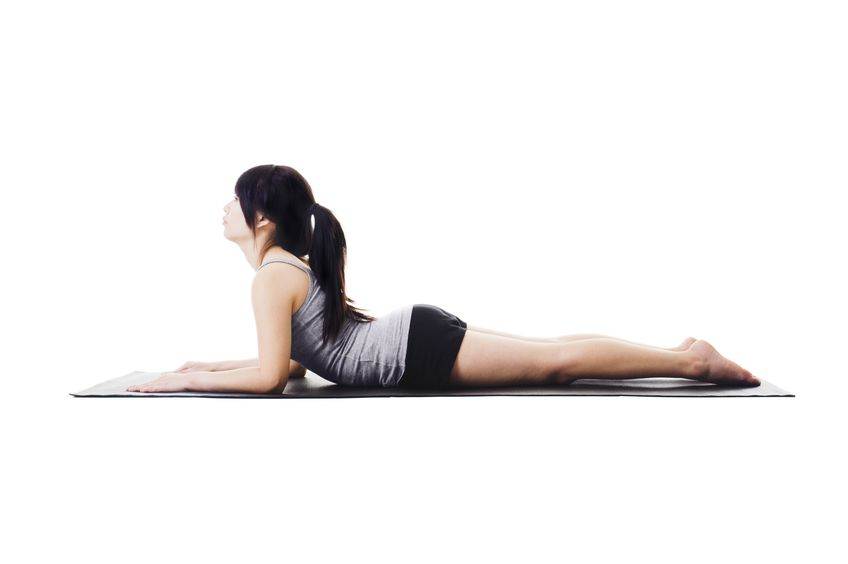
- Get into the prone position lying down on your stomach.
- Next, get on your elbows. If you have a hard time with this position go back into the prone lying position.
- Do these exercises hold each time for 1-2 seconds 6-8 times per set? This exercise can be repeated every two hours throughout the day.
Asses yourself. If the pain has decreased or the pain has moved away from the leg or thigh and into the hip or buttock, this is an improvement. Even if the pain is increased in the back but relieved in the leg this is an improvement and a green light that you should continue this exercise. You also get a green light if there is no difference at all.
- If your self-assessment gives you the green light, move on to the Cobra exercises just below.
- If your thigh or leg pain is worse, then stop right away.
- If your lower back, thighs and legs are the same you get a green light, so move on to the Cobra exercises.
#3 Cobras For Lumbar Herniated Disc
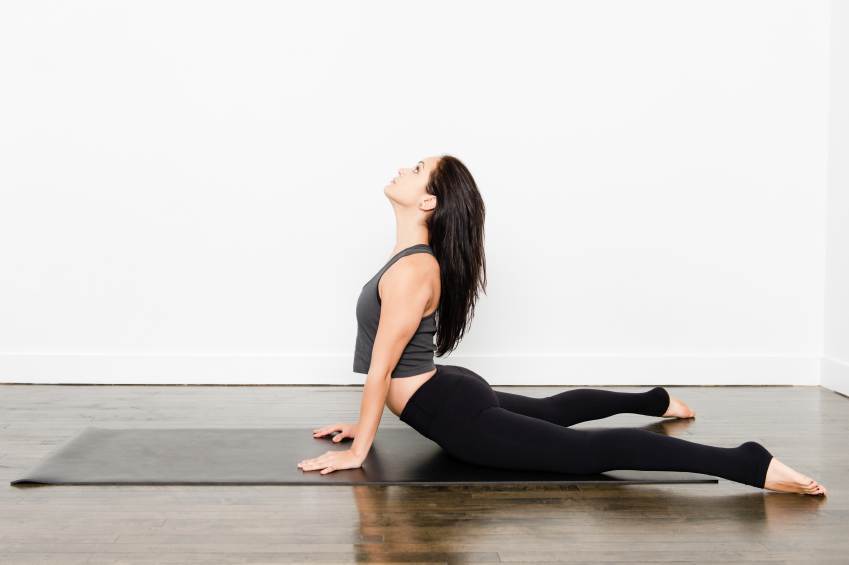
- Lie down face down with your hands underneath your shoulders.
- Push up from as high as you can until your lower back stops you or your elbows are straight.
- The pelvis should still be on the floor and the lower back muscles relaxed.
- Do these exercises hold each time for 1-2 seconds 6-8 times per set? This exercise can be repeated every two hours throughout the day.
Asses yourself. If the pain has decreased or the pain has moved away from the leg or thigh and into the hip or buttock, this is an improvement. Even if the pain is increased in the back but relieved in the leg this is an improvement and a green light that you should continue this exercise. If your thigh or leg pain is worse, then stop right away.
#4 Standing Extensions Lumbar Herniated Disc
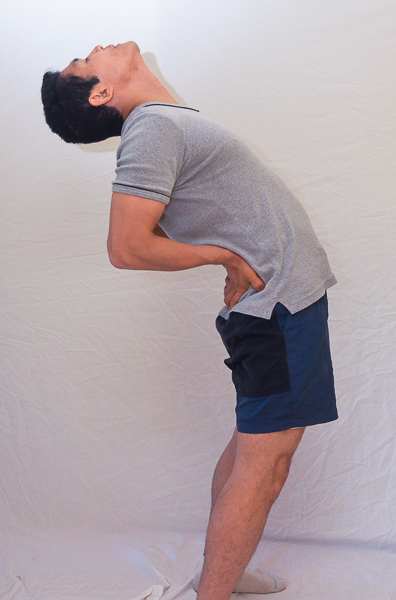
- Stand straight and put your hands behind your hips with your fingers facing down.
- Push your hands into your pelvis so that your lower back arches.
- Don’t use your lower back muscles
- These exercises can be done 6-8 times for 1-2 seconds. This exercise can be repeated every two hours throughout the day.
Stabilization Exercises: Prevent Your Disc From Coming Out By Having A Stable Spine.
#1 Cat-Camel or Cat-Camel For Herniated Disc
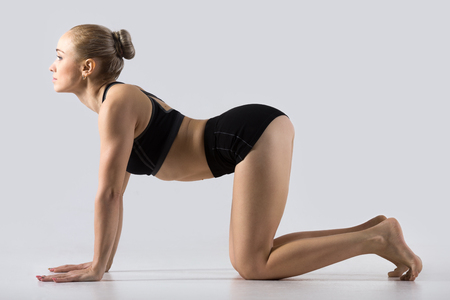
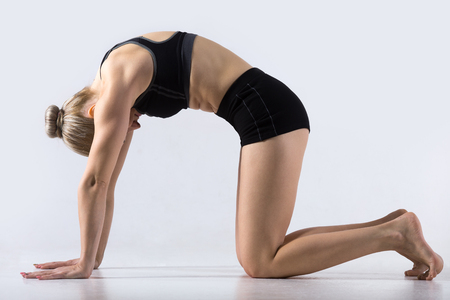
- On all fours with your knees under your hips and hands under your shoulders.
- Inhale and let your belly fall downwards toward the floor as you look up toward the ceiling for 2 seconds.
- Exhale and arch your back up as far as it will go or until you feel pain. You should not feel pain with this exercise, otherwise you are going too high.
- At the same time bend your neck forward and look toward your navel.
#2 Curl-Ups
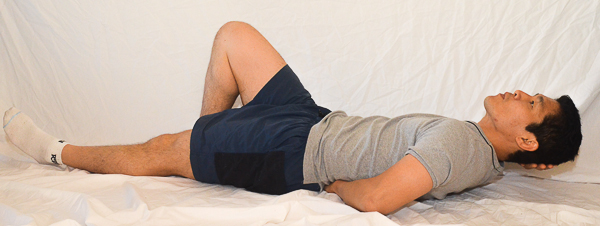
- To start, one foot is bent and the other is straight.
- One forearm goes under the arch of your lower back to support it.
- The other arm is supporting your head.
- Your head and neck come up as one block until your shoulder blades clear the floor.
- Do three sets of 5 working your way up to 10. If it’s easy, then hold for a couple of breaths.
#3 Squats
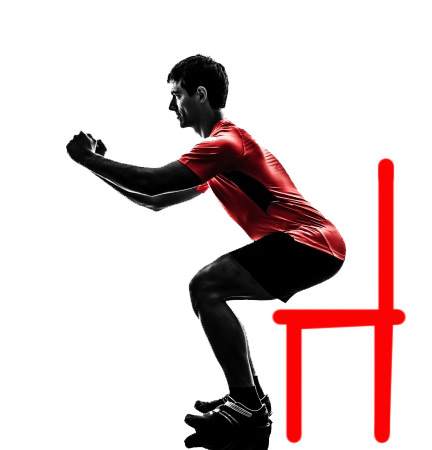
- Stand in front of a chair as if you are going to sit on it.
- Stand with your feet facing slightly more outward than your knee.
- Make sure your butt comes out, and keep lowering your butt until you touch the chair.
- Practice 3 sets of 10.
#4 Bird Dog
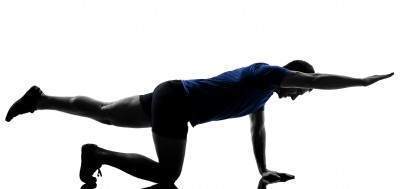
- Get into a crawling position with your hands and feet shoulder-width apart.
- Harden your core by contracting your abs and lower back. This is called bracing.
- Lift your arm first. If this is easy, then lift your leg only. If that is easy, then lift the opposite legs and arms, for example, right leg, and left arm.
- Want to make it tougher? Try lifting an arm and leg on the same side.
- 3 sets of 10. If you are shaking a little or cannot balance quite right, you’re doing the right exercise for you, i.e. lifting just the leg or arm might be easy, but lifting opposite arms and legs might put you off-balance a bit. Make sure you are stable before going to the advanced bird dog.
Tell us what you think in the comments below and like us on Facebook. This Toronto Downtown Chiropractor will answer all questions in the comments section. Let us know your vote for the best Toronto chiropractor in the comments section.
References
1. J Med Genet 2002;39:387-390 doi:10.1136/jmg.39.6.387


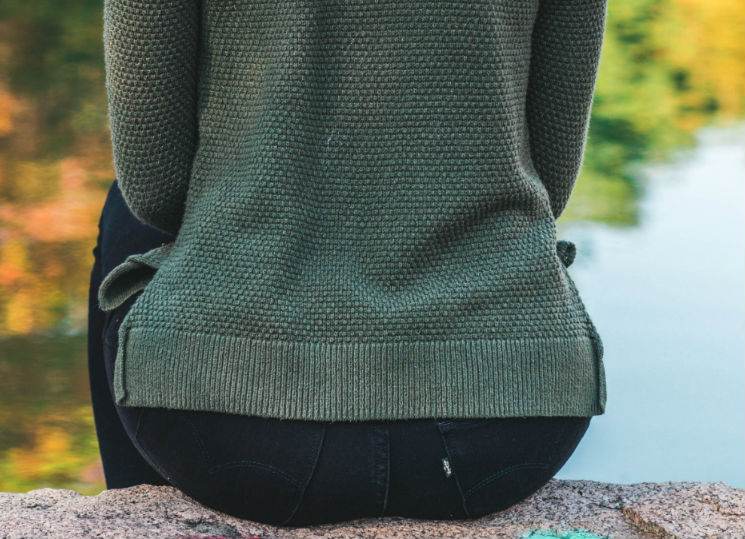
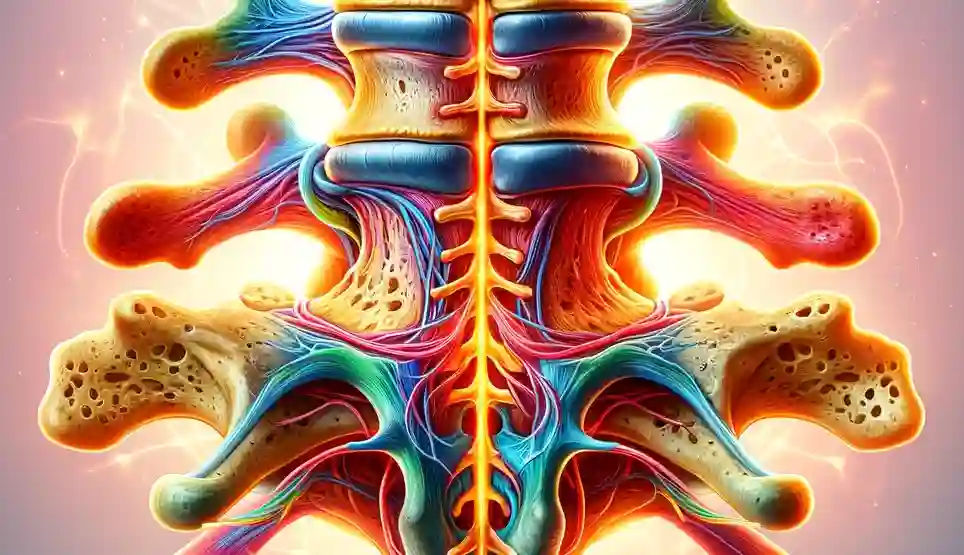
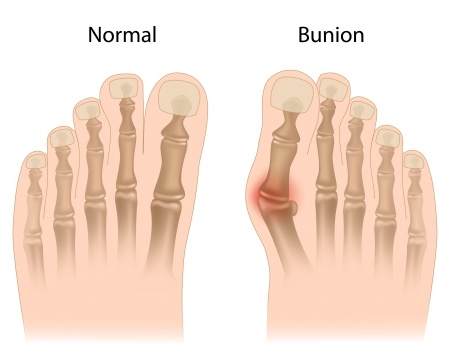
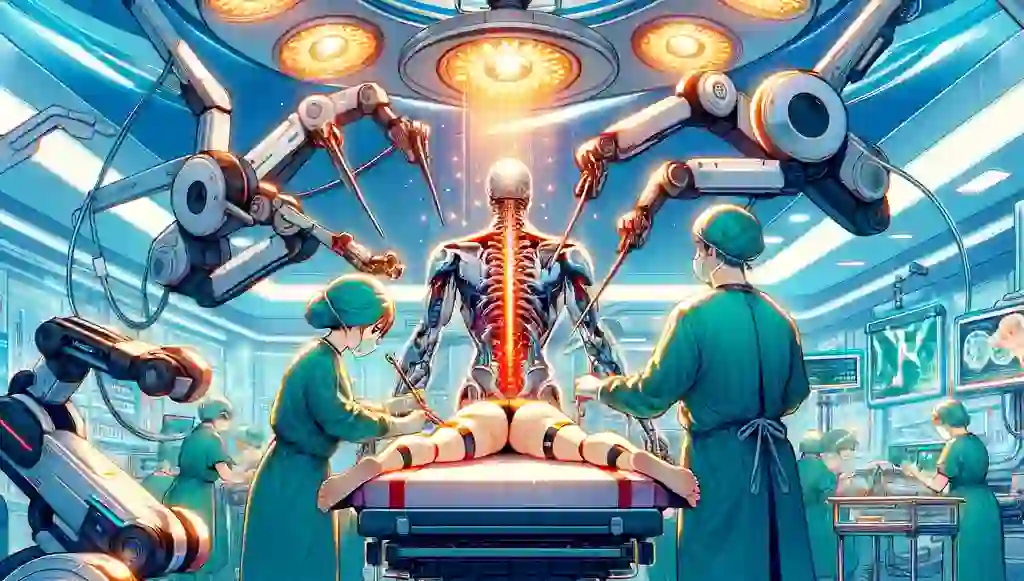
is leg raising while laying down with towel rolled support lower back curve is a good exercise for herniated disc? Progression from bent leg to straight leg raises.
Author
Thanks for your question Wesley. That will likely aggravate your nerve if the nerve is stuck near the disc. This will stretch the nerve and you will feel more pain.
Hope that help your herniated disc.
Dr. Nakamura, I had injured my back bowling in ’94. The MRI stated annular broad-based fissure and bulge at L5/S1. I have been to different doctors, chiropractors over the years many times. The pain has been constant at that area since then, I had a few epidurals, walking, stretching, Advil and ice have been my go to elements to take the edge off over the years, bed rest once a year or so when it would slip out and I couldnt walk for a several days. The past 1.5 years have often getting accompanied buttock pain, can’t leg up. A recent MRI, doctor states that particular pain is more likely caused by facet joint syndrome. This is a long time problem, but recently gotten worse.I am also concerned about possible ligament “instability” from some of the low back gonstead method adjustments I received in the late 90s. I would like to see a chiropractor again however, Any advice for me?
Author
Thanks for your question Tony. I am assuming that when you say “can’t leg up” it means that you have a hard time bringing your leg up while laying down? If not tell me what you mean.
So you are looking at an article on disc herniation and saying you have facet syndrome and have concerns about instability. Chiropractic can help with facet syndrome since that’s what it does well through manipulation. You also say you are concerned about instability. Instability can come about for a number of reasons including trauma and degeneration and pars fracture from repetitive strain. Since you’ve had back problems continuously since then it’s likely that you have degenerative related instability. Also is this a confirmed diagnosis or it this a self-diagnosis based on clicking that you hear in your lower back area when you move. Keep in mind clicking is normal in a degenerated spine.
If the chiropractor helped you before chances are that it will help you again although there is no guarantee.
The above is an opinion, not a recommendation.
Hope that helps your possible facet syndrome.
I have pain on my right leg,the pain began from lower back bt after massaging the pain went down to leg I have gone to various hospital bt immediately after medication de problem goes back afresh. What do I do am so worried
Author
Thanks for your question Josephine. It may not be the massage but the fact that you were laying down face down (prone) for a long period of time. If you have a certain type of back this can make you worse. You can try the exercises but you should have the exercises guided by someone familiar with them. A chiropractor or physiotherapist in your local area may be able to help at least for the first few times. This is an opinion and not a recommendation.
Hope that helps your possible disc herniation.
HI, this exercises works for L3/l4 & L4/L5 POSTERIOR disc herniation?
Author
Thanks for your question Fabian. Yes, the exercises work however everyone is different. You may have to customise the exercises but for most people it works. Not every exercise helps everybody.
For some the exercises will make them worse. You then have to change the exercise. As it is different for each person I cannot do that for you. This is a opinion and not a recommendation.
Hope that helps your herniated disc.
hi dr. ken
I am 33 years old male with L4 L5 disc herniation pinched nerve that affected my leg. Affected already more than a year on and off. The Cobra exercise works well for me because I got his problem from bending forward too much.
Now I have new pain in my right side hip butt and flank area from taking step with my right foot. The pain ease off after Cobra exercise. I suspected this has to do with my walking with havaianas flip flops only daily 3-4 hours long distance which started couple weeks. and the pain started as well now.
question is long distance flip flop walking bad for your back?
thx
randy
Author
Thanks for your question Randy. Walking with flip flops long distances depends on your walk. See, most people have slightly flattened feet. With flat feet your leg will turn in putting more pressure on the knee eventually causing the hip to turn in slightly more. This can eventually affect the back. The further you are from perfection with regards to your feet the earlier you will have problems in one of the areas I talked about above.
With regards to your new in the hip, buttock and flank area. It likely means you aggravated the same problem but to a lesser extent than before. This is an opinion and not a recommendation.
Hope that helps your possible reherniation of your disc.
thx lots, YOU ARE A GREAT MAN!
Author
You are welcome Randy.
Hello Dr. Ken,
My MRI imaging shows :
diffuse posterior bulge of l5-s1 disc with right paracentral extrusion compression right side traversing nerve roots and thecal sac.
Could you please tell which exercise should i do?
The MRI imaging is of 3 months back, and since then i was only doing light walking for half an hour every morning with no other exercise and spending nearly 7 hours each day on bed (not continious bed rest, as it include 15-20min walk after every 3 hour) . The pain in right leg till ankle is still same as it was three months back.
Thanks,
Author
Thanks for your question Sumit. You need to see the best local chiropractor or physiotherapist in your area. This is an opinion not a recommendation.
Hope that helps your disc extrusion.
Thanks Ken.
I have started with a local physiotherapist now. Hope it get better without surgery.
Author
Best of luck.
Hello Dr
I have what is thought to be a prolapsed L5 S1, MRI results pending. It happened 5 weeks ago. I have lower back pain and pain in my left leg right down to my foot. I have had more severe pain in my lower back since starting Mckenzie’s which has centralised from my leg, this is now settling. Despite less pain I have a lot of numbness in my two little toes, under my foot, my heel and ankle. I have slight numbness in my calf and my outer thigh. I cannot lie on the affected side as the numbness gets worse. I have seen two physiotherapists, neither seem overly concerned by this numbness, but I am. I had lost strength in the leg which seems to be returning as the pain reduces, however the numbness feels like it is getting worse. My questions are – will I get full feeling back? How long might this take? Will the exercises help? What is the likelihood of full recovery? I am 42, female, healthy, normal weight and a runner (or was 🙁 ) With thanks Rebecca
Author
Thanks for your question Rebecca. The numbness is cause for concern but the pain is more important. In fact, it is not uncommon for people to left with some numbness even when they are pain-free after a severe disc herniation. Treating the pain and your ability to function like sitting, lying down and standing are far more important. If you can’t function then you can’t work or enjoy life. If you get full feeling back it can take weeks to months. There are no guarantees but most people do get the feeling back. Having said that your situation sounds more severe than average.
This is an opinion and not a recommendation.
Hope that helps your numbness from your herniated disc.
I am diagnosed to have disc protrusion of L3 to L5 and nerve compression on my s1. Can i also do the exercises listed here?
Author
Thanks for your question Anne. You will have to tell me your symptoms in detail to give you an opinion.
Hope you understand that a disc protrusion can be going out one way but behave in a different way.
Hello,
I’ve symptoms I’ve not read about in forums. Pain in the inguinal and psoas, on a diagonal going down from the plane of my navel to the symphysis pubis. I have suffered being unable to sit for 6 months, or less tragically, am also unable to bend over. I sit for a living, and don’t have a choice, but found that a kneeling chair helps. Physiotherapy, which I tried first, failed to help with exercises for what they thought was a tight psoas (only happens on the left) and weak core, and nothing seems to help the pain except not sitting or bending. I can only sleep on my back. MRI showed a left foraminal extrusion on the L1 disc, consistent with my symptoms. Which of your physio exercises would be appropriate? I’ve had two steroidal injections with a skilled radiologist under floroscope, but it’s a difficult area, and I’ve had limited success with that. Thanks for answering. I understand it’s a rarer herniation.
Author
Thanks for your question Helene. I would do all the exercises but focus on the extensions. However like all exercises they can make you worse. You have to stop immediately if the symptoms start going down the leg. Hope that helps your herniated disc.
This is an opinion and not a recommendation.
hi Doc,
my husband was diagnosed with slipped disc 2 mos ago and is now ok,his body activities are back to normal .he did not undergo operation. the Doc said ,based on his MRi, on a scale of 1-10, his slipped disc is at number 4.so no need to think about operation at this time just take extra care when lifting heavy loads.
so,for the past 3 days ,he jogged a little.and he felt pain on his lower back,so I suppose jogging is not a good exercise. he wanted to go to the gym. what gym exercises would be advisable for his condition? thanks
Author
Thanks for your question Febie. Most gym exercises will make him worse if it is a typical disc. Try the exercises here first. Remember though that any exercise can make you worse. If the pain, numbness or tingling goes further down the leg then you are getting worse and you should stop the exercises. This is an opinion, not a recommendation.
Doc, can sciatic nerve compression from a piriformis muscle cause a calf muscle to become so weak, tight and sore that you can not raise your heel off the ground? Or can only a herniated or bulging disc cause this? I’ve always felt that my sacrum, glutes, and lower back were never built efficiently. One morning I developed a bad muscle cramp in my glute muscles which led to sciatica and twitching all down my leg while lying down. Standing back up hurt really bad but all pain disappeared once I started walking around. When I sat on the toilet, the pressure on my glute muscle sent a huge jolt down my nerve and my calf was basically dead for months and slowly gained strength over the next year. It’s been two years and my left calf is still smaller and weaker than my right. But I can do full calf raises again on that foot. it fatigues much quicker than my right though. I never had an MRI and couldn’t see a doctor because I had just lost my job and health insurance before this happened. I ruled out a herniated disc because I never felt pain in my lower back. But now I’m noticing that certain movements (mostly if I’m lying on my stomach and try to squirm forward like a snake) will cause serious pain right in my lumbar area in the spine, like a bruised feeling. Also in the morning I can’t bend forward to wash my face in the sink, and I have to find innovative ways to put my shoes and socks on or I worry I might herniate a disc.
Author
Thanks for your great description Kasey. Doesn’t sound like piriformis syndrome. It’s a disc problem from what you have described. Only an examination can confirm this though. I treat plenty of people with disc herniations that have no pain in the lower back. Just the hip or just the buttock just the calf or just the back of the thigh. It’s not as common but it’s not rare.
You can try the exercises in this article but you can get worse. You know you are getting worse if the pain goes further down the leg. This is an opinion and not a recommendation.
Hope that helps your likely disc herniation.
First, let me say as someone who has had back issues for 20+ years and read everything I could, I find your site to be one of the most informative. You articles are thoughtful, detailed, and informative.
I’m at a crossroads and each doctor I speak to gives me different advice. I really respect your thoughtful responses and would appreciate any thoughts you may have.
Im in my mid 40s and I have had back problems going back to my college days. Every year or so I get an “episode” that lasts a few weeks (or a month or two) and resolves on its own (or with some chirp, PT, oral steroids and/or injections). My most recent episode is very different.
In early June – I started having mild back pain
In mid June – It moved to the glut/periformis region
In late June I was having sciatic pain down my right leg. My ortho doctor gave me a 5 day oral steroid treatment that made me feel a bit better but didn’t really resolve the issue.
In early Aug I took a step back. The sciatic symptoms got worse. I had tingling, pins/needles, numbness in my foot, and eventually had weakness in my calf.
In mid Aug the doctor administered an epidural injection. Pain decreased a bit, tingling mostly gone, and numbness decreased. However, the calf weakness persists. I cannot stand on my tip toe on my right leg.
Met wth ortho surgeon last week. Who said the weakness may or may not resolve on its own. He suggested a micro-discectomy but couldn’t promise the nerve function would return to 100%.
I’m seeing a Neurologist next week.
My issue is as follows: I have ABSOLUTELY NO PAIN at the moment. My back actually feels great! The tingling is only occasional and the numbness has gone down a bit. The only remaining symptom is the weakness. Surgeon didn’t think chirp, PT or acupuncture or anything would help. His thought was it would either resolve or not. Surgery would help but not guarantee nerve improvement. He did say that waiting would decrease chances of recovering the nerve but at the same time didn’t rush to schedule my surgery.
I’m concerned about doing a surgery when I actually feel fine. I do want the weakness to go away (and will start PT and acupuncture again this week) but also don’t want to wait too long if it means I am further damaging the nerve. I’ve casually spoken to a number of doctors and half are in the do it camp and half are in the wait a few weeks (or longer) camp.
I would love to get your thoughts. My main question is whether there are things I can do to recover calf strength.
Author
Thanks for your question Ian. While your surgeon “thinks” PT or acupuncture or anything” the surgeon doesn’t actually know. I personally wouldn’t go near that surgeon as they should encourage conservative care first. Unless the weakness is continually getting worse my trust of that surgeon would be gone. That’s just my opinion, though. Surgery would be my last option.
To answer your question it looks like an S1 pinched nerve at L5S1. In order to treat that you need to treat your back to take the pressure off the nerve. I would try the exercises here in this article emphasising the extensions. I would do the extensions 4X 10 or 40 times a day spread apart every 3-4 hours.
Remember though that the exercises can make you worse. If you feel worse stop the exercises right away.
I am giving you an opinion, not a recommendation.
Hope that helps your possible disc herniation.
Hello Dr. Ken.I am 31 year male.I had history of recurrent back pain problem. But about 5 years back got exaggerated along with pain in left leg.which got fine after 1month rest and a homeopathy medicine.But sometimes I felt very little numbness along the sciatic nerve from back of thigh to feet.On 16/4/16 suddenly I got enormous pain in left leg.which got settled in 20 days due to some allopathic medicines.But there was numbness in left leg same as before but with more width thus more area. And tingling in fingers.Then I got MRI on 24/4/16, which said –
>loss of lumbar lordosis
>small marginal osteophytes noted from L1 to L5 levels.
>Desiccated L2-3, L3-4 & L4-5 intervertebral discs with reduced L4-5 disc height.
>Central & left paracentral L4-5 disc extrusion & caudal migration causing thecal sac indentation, left L5 lateral recess compromise with bilateral neural foraminal stenosis ( L>R).
>posterocentral L3-4 disc protrusion causing thecal sac indentation
> mild L2-3 annular disc bulge causing thecal sac indentation.
>rest of intervertebral discs unremarkable.
> lumbar spondylosis with paravertebral muscle spasm.
After 1 month rest I meet physiotherapist who gave me 15 days traction with some exercises.which included a stretching exercise of bending forward to touch knee with forehead.But know I am surprised after reading your article that how can my physiotherapist ask me to bend forward! Nevertheless about 10 days back I had to sit for abut 8 hrs due to which my pain returned in my buttock and waist. right now I’m taking rest. Pain has reduced but when I do flossing I feel pin point pain just below waist .My numbness and tingling is same as before.And now when I press my L4-5 region, I feel little pain.please help me Sir.
Advice me.
Hi Just had my scan results back! I have right paracentral disc herniation L4-L5 which I have been told is just protruding millimeters! I also have early central disc herniation L5-S1 ! I have been suffering with extreme pain for the last 17 weeks ! Now I cant argue with the scan results but along with all the sciatica symptoms, shooting pain, pins and needles, toe pain, aching behind knees etc etc I have major cramping and spasms in my right buttock (this is actually what came first) I was wondering if perhaps this has something to do with my piriformis muscle, it does help with deep massage and seems to loosen, this area is extremely tender I also have pain in my buttock when passing a stool! When this area is loosened the sciatica pain does decrease! I cant seem to get anywhere with my doctor and they have just referred me for operation! Obviously you can only advise but have you come across this before! Im actually a yoga teacher and am very aware of my body although not an expert, I know what positions aggravate and help! Forwards bends absolutely set it off and as its a central herniation I thought these would help more! Any thoughts??? Many many thanks Hazel
Author
Thanks for your question Hazel. I treat many Yoga teachers. First, an MRI can be very wrong. What I mean is that if your MRI was taken while lying down like most, then it’s not giving you an accurate picture. You said that forward bending is what sets it off. Well the MRI was not taken while you were sitting or most definitely while bending forward. It’s a fact that is more pressure on the disc when bending forward compared to lying down. So the MRI only give you a picture that doesn’t reflect reality as you don’t lie down all day.
In addition, most people that have disc herniations feels better when their piriformis is treated. That is normal. It is not likely piriformis syndrome as this condition wouldn’t get worse with forward bending but a typical disc herniation will.
The above is an opinion, not a recommendation. I would concentrate on the extension exercises along with the other exercises at least 4 times a day.
Hope that helps your herniated disc.
I am 48 years. I used to work out at the gym regularly. 4 months back, the symptoms started with “pins and needles” sensation in my legs and aggravated into severe pain in my right buttock.
On my right leg, there was light pain on the external calf region and numbness of the toes. I used to feel better if I sit down or lie down on my back.
My MRI report was as follows:
Posteocentral and bilateral paracentral disc protrusion at L4-5 level is compressing the thecal sac and both L5 traversing nerve roots (left > right)
Diffuse posterior disc bulge at L5 -S1 levcel is compressing the theca sac and mildly indenting both S1 traversing nerve roots
I started with 2 weeks of bed-rest, traction and physiotherapy (Ultrasound, IFT and TENSE). I had been taking muscle relaxant and pain killers as well.
There was improvement and I started on exercises including
1. Straight leg raises (lying down, I ft high)
2. Knee – Chest flexion (lying down)
The condition then worsened.
Even if the pain was less while lying down, getting up will cause severe tingling of my right feet and calf region and there would be pain era my right buttock. The pain use to radiate to just below the knees. There had been instances when even lying down will not relax the pain. I had to get back to pain killers
I started on Steroids and Painkillers and the pain reduced considerably.
Now I am restarted my exercise with
1. Knee – Chest flexion (lying down)
2. Mild side twists with bend knees (lying down)
Once again the pain seems to be increasing.
Please advice.
Author
Thanks for your question Vijay. Sounds like the exercises are making you worse. The exercises are making you worse if you are worse while doing the exercises or shortly after, not 2 hours later. Assuming that the exercises are making you worse than you should stop the exercises. Try the exercises in this article. You should do the exercises 4 times a day concentrating on the extensions.
Like any exercise the exercises in this article can make you worse. You are getting worse if the pain, numbness or tingling goes further down into your foot. You should then stop the exercises immediately.
This is an opinion, not a recommendation.
Hello Dr,
I am having scaitica from last 6 yrs but it is not constant ,come and go but this time it is there from last 2 months and i feel pain in back of thigh and upto knee and fell pan while walking and standing . sitting is ok .i am consulting a chiropractor . but still not able to understand what is the problem , shall i go spine specialist for consultation ? below is my MRI report , can you suggest me what problem actually is and which streach will be helpful in this case . strange thing is thigh pain cause radiating pain in ribs muscles .
INDICATION: 34 year old with left leg pain x4 weeks.
PROCEDURE: Standard sequences were performed.
FINDINGS: Evident on sagittal T2 images 7 and 8 of series 2, there is focal left lateral recess
stenosis at L5-S1 due to a left central disc protrusion/extrusion, suggesting potential irritation of
descending left S1 nerve root (further detailed below). Nevertheless, there is no spinal fracture,
compression deformity or intraosseous lesion and no pars defect or spondylolisthesis. The conus
medullaris terminates in normal fashion at the L1-2 level. Cuts through the retroperitoneum show no
aortic aneurysm, dissection or paravertebral soft tissue mass.
T11-12 to L4-5: Negative.
L5-S1: The disc is desiccated, mildly narrowed and associated with a small left central
protrusion/extrusion, causing moderate severe left lateral recess compromise, with posterior
displacement of the traversing left S1 nerve root. However, the central spinal canal, right lateral
recess and both L5-S1 neuroforamen remain patent.
IMPRESSION:
1.Moderate severe left lateral recess stenosis at L5-S1 due to a small left central disc
protrusion/extrusion.
2.Higher disc levels from T11-12 to L4-5 remain unremarkable.
3.No osseous trauma or spondylolisthesis. No evidence of a spinal infection or bone tumor.
4.No abnormal distal thoracic cord signal or syrinx
Hi Dr. I am 21 years old I had my MRI last febreuary and the report says :- 1-L5-S1 intervetebal disk space is partially hypointense on t2 and narrowed with symmetric disk bulge.
2- Normal morphological feature and signal of para lumbar muscles.
3- Multilevel discovertebral degenerative disease with L5-S1 disc bulge without nerve root compression.
Therefore , I am asking if its a serious injury or I can continue my workout.
Author
Thanks for your question Micheal. First, you shouldn’t decide things based purely on MRI. That’s what you are asking me to do. If you have severe pain that goes from the buttock into the foot that’s constant then it’s more serious. I can’t tell you based on only an MRI.
Hope you understand you don’t treat the MRI you always treat the person.
Hello
I belive I have a herniated disc at L5-S1. It started of with low back pain, but I didn’t pay too much attention to it, as I have had low back pain before. I was able to work out and go to wo0rk with the pain. Staying active helped to alleviate the pain. There was also some pain when coughing in the beginning, but that’s gone now.
After a month, and a long overseas flight I started to feel some pain in my upper right thigh and pins and needles thoughout my leg. I also noticed some muscle atrophy. I did see a doctor, that said my sensibility, reflexes and strength are symmetrical, and that I willo be fine as long as it doesn’t worsen. I have no bladder/bowl issues, the pain in my leg and back is hardly there at all, but I still have pins and needles in my both my feet up till the knee. More so in my right leg. I walk a lot, because that helps to alleviate the pins and needles. I also have two little children, so there are a few positions I have to get into that probably aren’t very beneficial for me.
I ave no problems sleeping, walking, walking stairs, hiking etc. My only issue right now is the pins and needles. They are hardly there when I wake up in the morning, but as soon as I start moving they’re back.
I do the mckenzie extension exercises every day and I also sit on a physio ball. However I do miss just lounging on the couch. 🙂
Will you please advise as to what I can do, shouldn’t do to improve and get rid of these pins and needles? I do exercises for my right leg, and I am already noticing a change in muscle mass. Any input is greatly appreciated. I am 32 years old.
Hi Ken , My name is Emmanuel I am recently diagonalisd with L4 L5 disc mild bulge cause narrowing of Neural foramina and abutting L5 traversing nerve root. And also Tiny posterior annualar tear is seen in L2L3 inter vertebral disc ,, ,, my systomps is slight pain in button and my right leg is stiffness and dull painful pain , heaviness and pain in thighs and little pain part of my calf down near ankle ,, but dull and sometimes painful , and not in the calf it self but down near the ankle ,, when turning my right hip and leg I turn it around like a robot,, but My left leg is completely normal ,, based on my reports if my MRI the problem I mentioned first was the only problem in Mri.. Advise what to ,, should do the exercises you put up here or should I go for nerve block first or should I go for prolothrop or Ozone /prolozone treatment …I am confused on what best to start with ,, pleas give me some of your sence,
Author
Thanks for your question Emmanuel. Why would someone not recommend more conservative treatment that isn’t as much invasive. Things like chiropractic or physiotherapy are usually very helpful. I would try the exercises here in this article. However you need you need to have them supervised by a health practitioner at least for the first time to see if they are really appropriate. You know if you are getting worse if the pain, numbness or tingling starts going further down the leg or or start to increase. If it’s worse you need to stop the exercises immediately.
Your symptoms do seem to correlate with the MRI
Hope that helps your disc herniation.
Thank you Ken
And I want to ask what is the meaning of abutting the travasl L5 nerve exit ,, I want to know if this meaning compressining my L5 nerve root or what ? I don’t understand the word abutting ,,, or did they mean my Nerve is Pinching at L5 ,,,
Author
Thanks for your question Emmanuel. It means that the disc is right up against the nerve. Since the MRI was taken while lying down, it means while sitting and standing the nerve would be pinched.
Hope that helps your herniated disc.
You are superior Dr Ken , thanks for helping me and other persons too. God bless
Author
You are welcome Emmanuel.
Dear doctor,
Since 3 weeks I have a huge shoulder and biceps pain and I undergone a MRI scan and here is the result:
Cervical spondylosis in the form of reduced disc height with desiccated disc at multiple levels.
Mild diffuse annular disc bulge at C2-3 level without any evidence of neural compression lesion or spinal canal stenosis.
Diffuse annular disc bulge with right paracentral disc protrusion at C4-C5 level indicating the ventral thecal sac and just impinging upon the exiting nerve root on right side.
Diffuse annular disc bulge with broad based disco-osteophytic complex lateralizing towards the right side at C3-C4 level, indenting the ventral thecal sac causing compression upon the exiting nerve root at the same level.
Diffuse annular disc bulge with broad based disco-osteophytic complex lateralizing towards the right side at C5-C6 level causing compression upon the exiting nerve root at the same level.
Diffuse annular disc bulge with broad based disco-osteophytic complex lateralizing towards the left side at C6-C7 level causing compression upon the exiting nerve root at the same level.
Your advise will be highly appreciated
Author
Thanks for your question Shiju. I cannot make recommendations based soley on an MRI.
Hope that helps your possible herniated disc.
Dr Ken, for the last 4 months, I’m suffering from disc bulge at L4L5 causing severe sciatica on right leg (from buttocks till calf), & mild disc protrusion on L5S1 which isn’t causing any pain to me. Sitting makes me comfortable & pain subsides most of the times. Leg raise test (right) still doesn’t goes beyond 40°. I’m now able to do mild walking & swimming. Also using inversion table at my gym. Mornings, I wake up fresh with no pain, but during the course of day – with work, movement & standing my body at pelvic region tilts slightly towards left & that warns me to lie down on bed & rest. My question is, which exercises shud I be practicing now & how many times? My pain in last 4 months (with OTC medicines) has definitely reduced, but not as much as expected.
Author
Thanks for your question Rajji. You should try knee to chest exercises holding for 1 second and repeating 10X. Do this 4X per day. If the pain gets worse or the pain, numbness or tingling goes further down the leg then you are getting worse. You need to stop immediately.
Thanks Dr. Ken. Assuming that you would recommend this, I am already doing this twice a day, and the pain improves for sure, but isn’t lasting. I try inversion table twice a day and it feels better combining with Knee to Chest sessions. Shud I continue with this (making to 4X)?
Author
You should do the exercises 4 times a day to start. Thanks for mentioning that. If all goes well and you don’t get worse, you should do the exercises every 2 hours.
Hope that helps your herniated disc.
Hello Dr Ken, I am writing to you exactly after one month of religious knee to chest exercises that you suggested. It happens just like a glide now…
Now, all if sudden my pain has shifted towards right hamstrings, which wasn’t there before at all.
After a hectic day I limp again & the spasm is more around lower butts & hams. What cud have caused this & which exercises you advise ?
Author
Thanks for your question Raji. You said previously that the exercises were helping but it wasn’t lasting. I suggested that you do the increase the frequency of the exercises 4X/ day and if continued to do better to do them every 2 hours. I also told you to stop right away if you got worse. As you said you had a hectic day so what was different about this day. I think the culprit lies in what you did that hectic day and not in the exercises. Also if you don’t get pain during or right after the exercises than it is not the exercises that made you worse.
I would try the exercises carefully again. This is an opinion and not a recommendation. Remember to stop the exercises right away if you get worse during or right after the exercises.
Hope that helps your herniated disc.